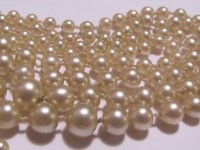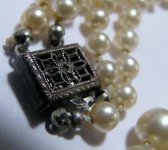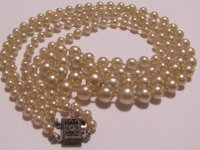You are using an out of date browser. It may not display this or other websites correctly.
You should upgrade or use an alternative browser.
You should upgrade or use an alternative browser.
Old Pearl Necklace What Kind of Pearls?
- Thread starter momsjewel
- Start date
pattye
Pearl Scholar
- Joined
- Dec 26, 2005
- Messages
- 11,462
These look like imitation pearls because of the consistency of their color and reflections, lack of customary blemishes and imperfections. Also the large holes, which seem to have a build up of the pearlized finish. If you look closely, you may also find some peeling around the holes.
Opinions from others?
Opinions from others?
Last edited:
Pearl Dreams
Pearl Enthusiast
- Joined
- Sep 24, 2007
- Messages
- 9,714
The second I saw them I thought, "Fake!"
JerseyPearl
Well-known member
- Joined
- Apr 25, 2014
- Messages
- 5,884
I would tend to agree that these are imitation pearls.
BWeaves
Well-known member
- Joined
- May 13, 2015
- Messages
- 7,319
The silver clasp and the bead cap ends are the type used on good imitation, vintage pearls. In other words, they are fakes, but they are nice fakes.
I have a similar strand from my grandmother. First, I gave them a good wash in soapy water. Then I cut them apart. I polished up the clasp while I had everything cut apart. Then I restrung them. They don't look as good as my real pearls, but I wear them occasionally and think of my Nana.
I have a similar strand from my grandmother. First, I gave them a good wash in soapy water. Then I cut them apart. I polished up the clasp while I had everything cut apart. Then I restrung them. They don't look as good as my real pearls, but I wear them occasionally and think of my Nana.
Camelotshadow
Well-known member
- Joined
- Jun 12, 2017
- Messages
- 361
One really should learn the feel of the pearl tooth test...its a great tool.
I won;t take the time to look at the pearl in the pics right now but they did use silver & those end caps on real pearls.
Not saying they are but from far they look decent & its a family piece.
Mikimoto even used silver & I have a piar from the 60's & they have AA pearls so they were decent.
I agree in general gold was used for better pearls but there are exceptions.
They do have a "painted finish"/ lack of natural blemishes & drill holes are large with build up around the drill hole as mentioned so I also agree faux..
I won;t take the time to look at the pearl in the pics right now but they did use silver & those end caps on real pearls.
Not saying they are but from far they look decent & its a family piece.
Mikimoto even used silver & I have a piar from the 60's & they have AA pearls so they were decent.
I agree in general gold was used for better pearls but there are exceptions.
They do have a "painted finish"/ lack of natural blemishes & drill holes are large with build up around the drill hole as mentioned so I also agree faux..
pattye
Pearl Scholar
- Joined
- Dec 26, 2005
- Messages
- 11,462
Especially once one has seen a few imitation pearls in person and knows what to look for, there is no need for a tooth test! One can gently rub one pearl gently against another to check for grittiness, my preferred method. Some faux pearls are gritty from d i r t, not something I want in my mouth.
Agreed, there are many examples of vintage genuine akoya and Mikis that are strung or mounted on sterling silver and employ the bead tips finish.
Many of the older faux pearls like these can be cleaned and restrung, restoring much of their former attractiveness and honoring their sentiment value. I so wish I still had my Mother's long strand of imitation pearls; she wore them for many, many years.
Agreed, there are many examples of vintage genuine akoya and Mikis that are strung or mounted on sterling silver and employ the bead tips finish.
Many of the older faux pearls like these can be cleaned and restrung, restoring much of their former attractiveness and honoring their sentiment value. I so wish I still had my Mother's long strand of imitation pearls; she wore them for many, many years.
I definitely was fooled and thought them to be real because I can feel some grit when I did the tooth test. I do now see where there is some excess pearl material around some of the drill holes with a loupe. Also, the outside looks a bit like 'orange peel' with the loupe and they do have a nice luster to them. This was quite the learning experience for me and I want to thank you all for your comments and for sharing your knowledge. It is GREATLY appreciated!
Pearl Dreams
Pearl Enthusiast
- Joined
- Sep 24, 2007
- Messages
- 9,714
I have also found that grime accumulated on imitation pearls can make them a bit resistant when rubbed against one's tooth or against each other. It's best to give them a good bath off before doing such tests.
In any case, imitation pearls can be a fun fashion alternative. If you like them enough to clean them up and restring them, I say go for it!
In any case, imitation pearls can be a fun fashion alternative. If you like them enough to clean them up and restring them, I say go for it!
Similar threads
- Replies
- 2
- Views
- 503
- Replies
- 2
- Views
- 438



